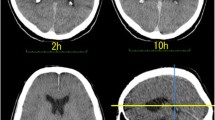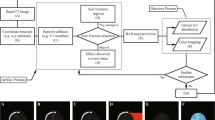Abstract
Purpose
The aim of this study was quantitatively to analyze brain edema and swelling due to early postmortem changes using computed tomography (CT) scans of the head.
Materials and methods
Review board approval was obtained, and informed consent was waived. A total of 41 patients who underwent head CT before and shortly after death were enrolled. Hounsfield units (HUs) of gray matter (GM) and white matter (WM) were measured at the levels of the basal ganglia, centrum semiovale, and high convexity area on both antemortem and postmortem CT. The length of the minor axis of the third ventricle at the level of the basal ganglia and the width of the central sulcus at the level of high convexity were measured.
Results
At each level tested, the HUs of GM and the GM/WM ratios on postmortem CT were significantly lower than those on antemortem CT (P < 0.001). HUs of WM on postmortem CT were slightly higher than those on antemortem CT but without significant difference (P > 0.1). Postmortem CT showed subtle loss of distinction between GM and WM. The size of the third ventricle and the width of the central sulcus did not vary before and after death (P > 0.1).
Conclusion
Early postmortem CT shows mild brain edema but does not show brain swelling.
Similar content being viewed by others
References
Mitka M. CT, MRI scans offer new tools for autopsy. JAMA 2007;298:392–393.
Bolliger SA, Thali MJ, Ross S, Buck U, Naether S, Vock P. Virtual autopsy using imaging: bridging radiologic and forensic science: a review of the Virtopsy and similar projects. Eur Radiol 2008;18:273–282.
O’Donnell C, Woodford N. Post-mortem radiology: a new subspeciality? Clin Radiol 2008;63:1189–1194.
Ezawa H, Shiotani S, Uchigasaki S. Autopsy imaging in Japan. Rechtsmedizin 2007;17:9–20.
Kaidou T. The concept and history of Ai (Ai no gainen, rekishi). In: Ohtomo K. The diagnostic guide of autopsy imaging (Outopushi imeizingu dokuei gaido) Tokyo: Bunkoudou; 2009. p. 2–23 (in Japanese).
Takahashi N, Higuchi T, Shiotani M, Maeda H, Sasaki O. Multiple lung tumors as the cause of death in a patient with subarachnoid hemorrhage: postmortem computed tomography study. Jpn J Radiol 2009;27:316–319.
Shiotani S, Kohno M, Ohashi N, Yamazaki K, Itai Y. Postmortem intravascular high-density fluid level (hypostasis): CT findings. J Comput Assist Tomogr 2002;26:892–893.
Takahashi N, Higuchi T, Shiotani M, Maeda H, Hirose Y. Intrahepatic gas at postmortem multislice computed tomography in cases of nontraumatic death. Jpn J Radiol 2009;27:264–268.
Shiotani S, Kohno M, Ohashi N, Yamazaki K, Nakayama H, Watanabe K, et al. Dilatation of the heart on postmortem computed tomography (PMCT) comparison with live CT. Radiat Med 2003;21:29–35.
Sarwar M, McCormick WF. Decrease in ventricular and sulcal size after death. Radiology 1978;127:409–411.
Dedouit F, Sévely A, Costagliola R, Otal P, Loubes-Lacroix F, Manelfe C, et al. Reversal sign on ante- and postmortem brain imaging in a newborn: report of one case. Forensic Sci Int 2008;182:e11–e14.
Torbey MT, Selim M, Knorr J, Bigelow C, Recht L. Quantitative analysis of the loss of distinction between gray and white matter in comatose patients after cardiac arrest. Stroke 2000;31:2163–2167.
Brooks RA, Di Chiro G, Keller MR. Explanation of cerebral white-gray contrast in computed tomography. J Comput Assist Tomogr 1980;4:489–491.
Rieth KG, Fujiwara K, Di Chiro G, Klatzo I, Brooks RA, Johnston GS, et al. Serial measurements of CT attenuation and specific gravity in experimental cerebral edema. Radiology 1980;135:343–348.
Dzialowski I, Weber J, Doerfler A, Forsting M, von Kummer R. Brain tissue water uptake after middle cerebral artery occlusion assessed with CT. J Neuroimaging 2004;14:42–48.
Unger E, Littlefield J, Gado M. Water content and water structure in CT and MR signal changes: possible influence in detection of early stroke. AJNR Am J Neuroradiol 1988;9:687–691.
Na DG, Kim EY, Ryoo JW, Lee KH, Roh HG, Kim SS, et al. CT sign of brain swelling without concomitant parenchymal hypoattenuation: comparison with diffusion- and perfusion-weighted MR imaging. Radiology 2005;235:992–998.
Liang D, Bhatta S, Gerzanich V, Simard JM. Cytotoxic edema: mechanisms of pathological cell swelling. Neurosurg Focus 2007;22:E2.
Iida K, Satoh H, Arita K, Nakahara T, Kurisu K, Ohtani M. Delayed hyperemia causing intracranial hypertension after cardiopulmonary resuscitation. Crit Care Med 1997;25:971–976.
Fujioka M, Okuchi K, Sakaki T, Hiramatsu K, Miyamoto S, Iwasaki S. Specific changes in human brain following reperfusion after cardiac arrest. Stroke 1994;25:2091–2095.
Kjos BO, Brant-Zawadzki M, Young RG. Early CT findings of global central nervous system hypoperfusion. AJR Am J Roentgenol 1983;141:1227–1232.
Bird CR, Drayer BP, Gilles FH. Pathophysiology of “reverse” edema in global cerebral ischemia. AJNR Am J Neuroradiol 1989;10:95–98.
Han BK, Towbin RB, De Courtem-Myers G, McLaurin RL, Ball WS Jr. Reversal sign on CT: effect of anoxic/ischemic cerebral injury in children. AJNR Am J Neuroradiol 1989;10:1191–1198.
Author information
Authors and Affiliations
Corresponding author
About this article
Cite this article
Takahashi, N., Satou, C., Higuchi, T. et al. Quantitative analysis of brain edema and swelling on early postmortem computed tomography: comparison with antemortem computed tomography. Jpn J Radiol 28, 349–354 (2010). https://doi.org/10.1007/s11604-010-0430-4
Received:
Accepted:
Published:
Issue Date:
DOI: https://doi.org/10.1007/s11604-010-0430-4




